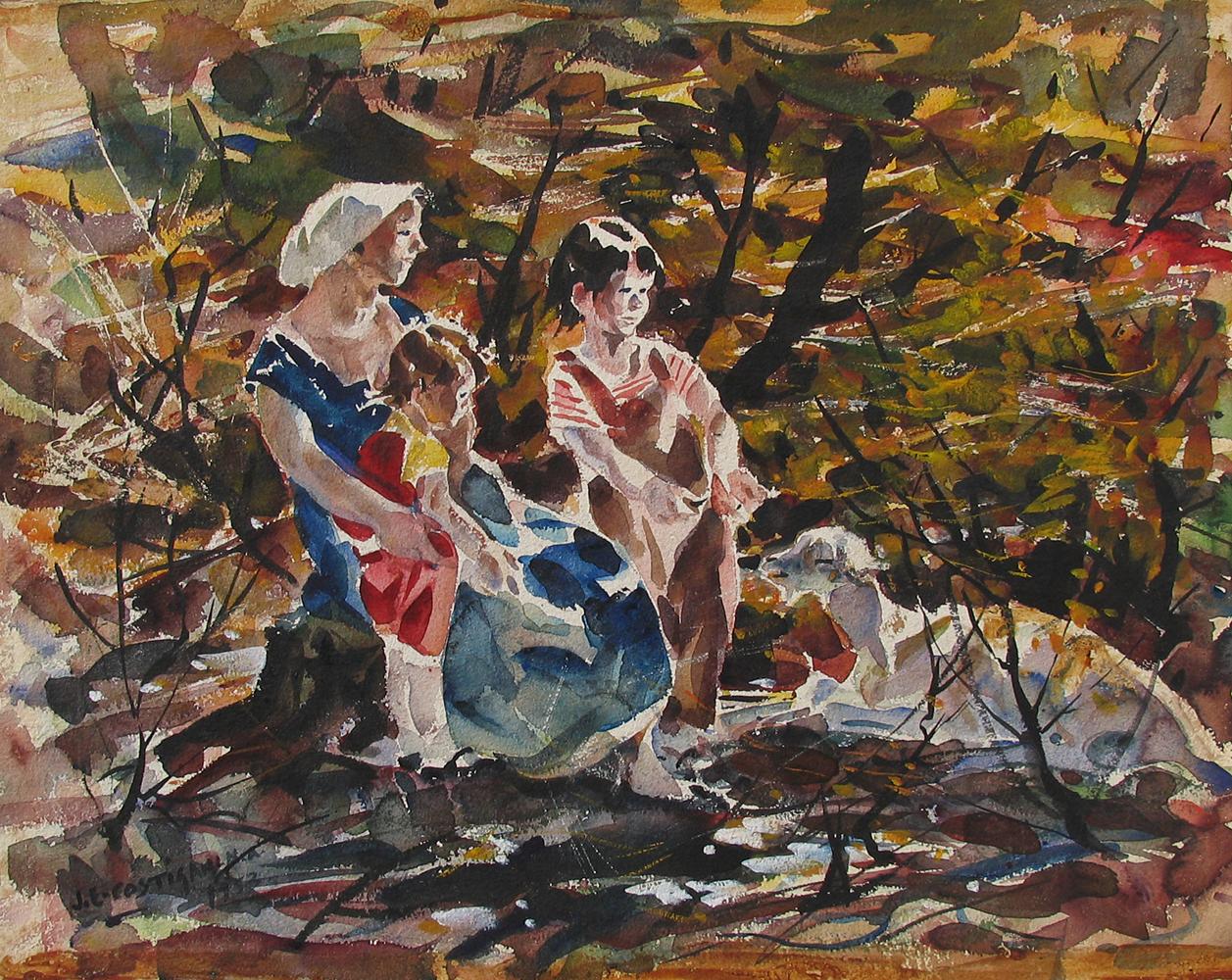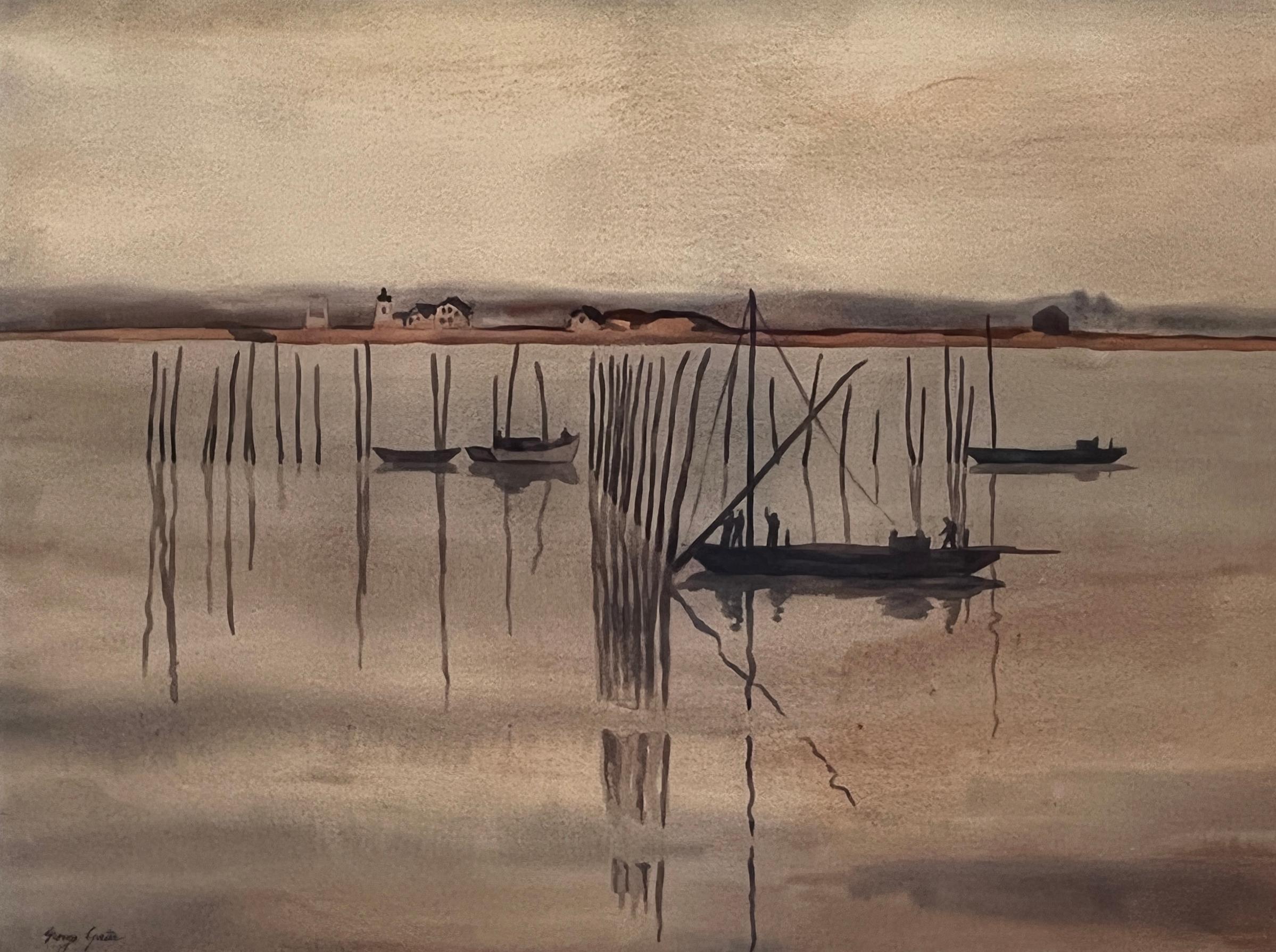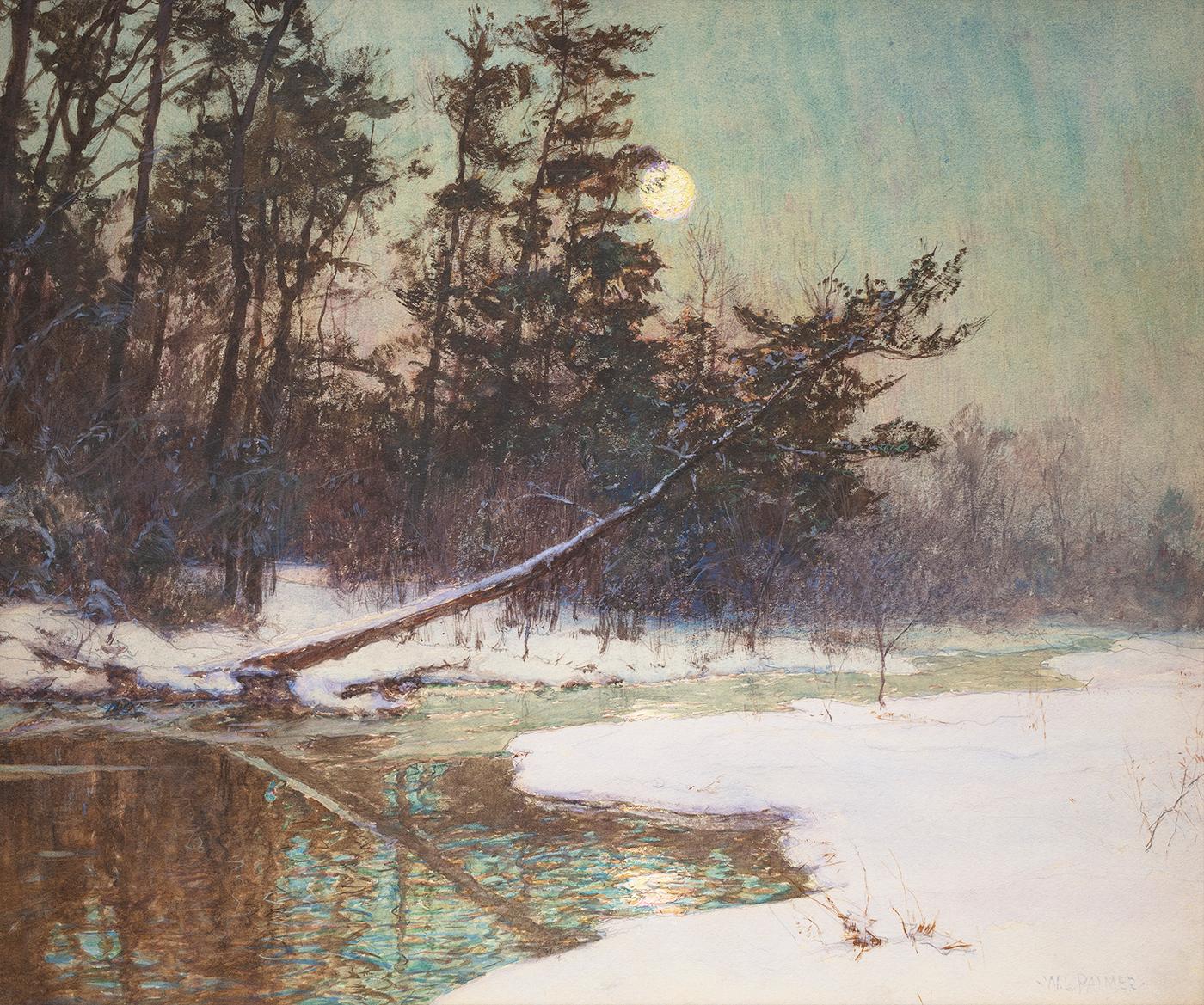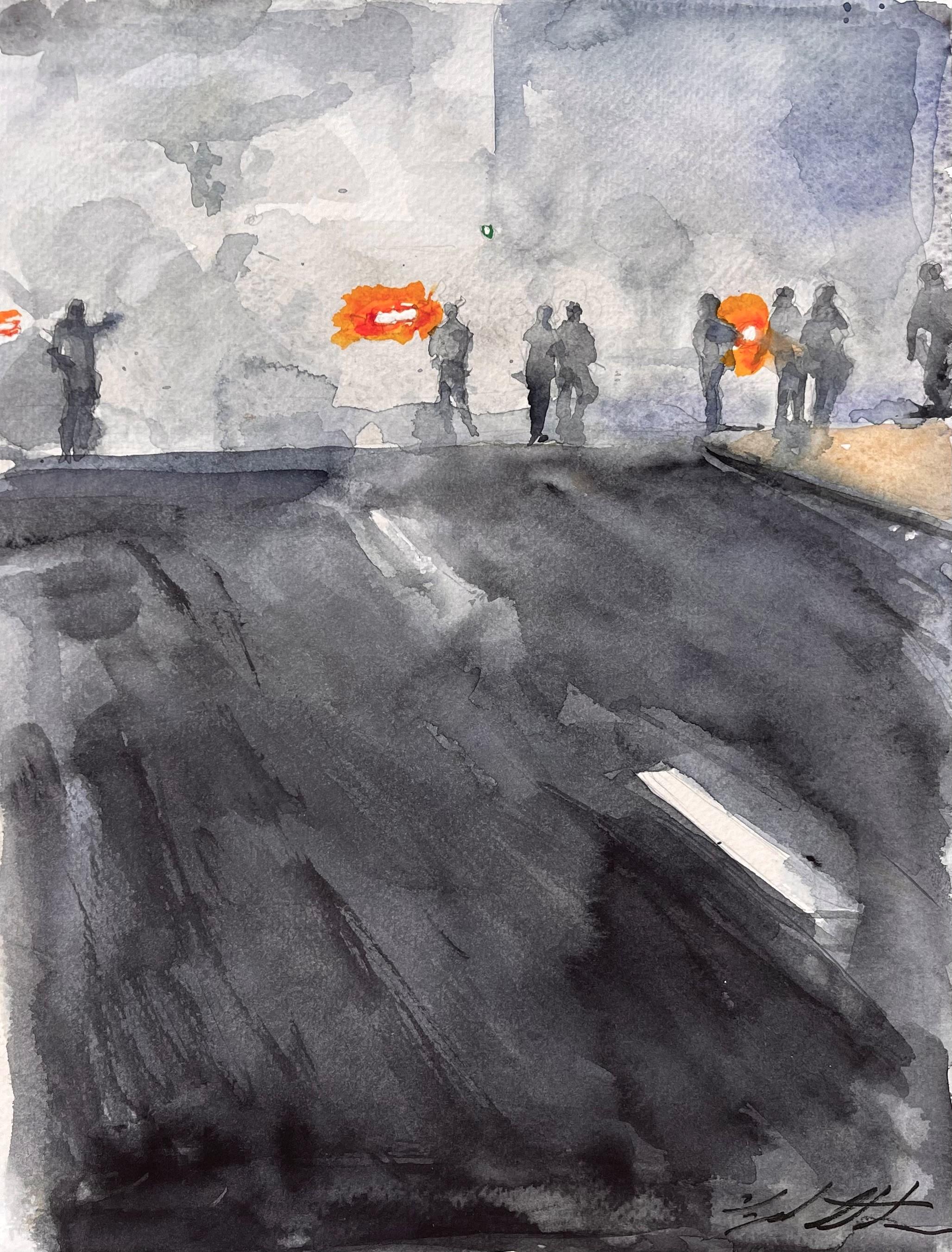Items Similar to "St. Ives in the Evening"
Want more images or videos?
Request additional images or videos from the seller
1 of 5
Hayley Lever"St. Ives in the Evening"c. 1910
c. 1910
About the Item
Jim’s of Lambertville is proud to offer this artwork.
Signed and dated lower right.
Hayley Lever (1876-1958)
Hayley Lever's exceptional career path took him from the shores of his native Australia to those of England, and then the United States. Described as an artist of "individuality," he refused to ally himself with any particular style or movement; rather, guided by his belief that "art is the re-creation of mood in line, form and color," he incorporated the precepts of Realism, Impressionism, Tonalism and Post-Impressionism into his art, applying those strategies in accordance with the emotion and aesthetic affect he wished to convey. In America, where he achieved his greatest acclaim, he was viewed as a proto-modernist, lauded by critics such as Edgar Holger Cahill, who declared:
"in all his painting, whether it is of boats dancing on the waters of the Cornish coast, the ferry bridges and boats and streets of Gloucester, Massachusetts, the steaming asphalt highways of New York City, or the gently upheaving Catskills about Woodstock, it is always Lever who addresses us."
Hayley Lever was born on September 28, 1875 in Bowden Tannery, a suburb of Adelaide, Australia. The son of Albion W. Lever and his wife, Catherine (Hayley) Lever, he was christened Richard, but as a professional artist he used his second and last names only.
- Creator:Hayley Lever (1876-1958, American)
- Creation Year:c. 1910
- Dimensions:Height: 15 in (38.1 cm)Width: 19 in (48.26 cm)Depth: 2 in (5.08 cm)
- Medium:
- Movement & Style:
- Period:
- Condition:
- Gallery Location:Lambertville, NJ
- Reference Number:
About the Seller
5.0
Vetted Seller
These experienced sellers undergo a comprehensive evaluation by our team of in-house experts.
Established in 1997
1stDibs seller since 2014
36 sales on 1stDibs
Typical response time: 6 hours
- ShippingRetrieving quote...Ships From: Lambertville, NJ
- Return PolicyThis item cannot be returned.
More From This SellerView All
- "Central Park"By William Langson LathropLocated in Lambertville, NJJim’s of Lambertville is proud to offer this artwork. Signed. Complemented by a hand carved and gilt frame. William L. Lathrop (1859-1938) Deemed “Father of the New Hope Art Colony”, William Langson Lathrop was born in Warren, Illinois. He was largely self-taught, having only studied briefly with William Merritt Chase in 1887, at the Art Students League. Lathrop first moved east in the early 1880s, and took a job at the Photoengraving Company in New York City. While there, he befriended a fellow employee, Henry B. Snell. The two men became lifelong friends and ultimately, both would be considered central figures among the New Hope Art Colony. Lathrop's early years as an artist were ones of continuing struggle. His efforts to break through in the New York art scene seemed futile, so he scraped enough money together to travel to Europe with Henry Snell in1888. There he met and married an English girl, Annie Burt. Upon returning to New York, he tried his hand at etching, making tools from old saw blades. Even though his prints were extremely beautiful, he still was impoverished. Lathrop would return to his family in Ohio, before once again attempting the New York art scene. In 1899, with great trepidation, he submitted five small watercolors to an exhibit at the New York Watercolor Club. He won the Evans Prize, the only award given, and four of the five paintings were sold the opening night. At age forty Lathrop’s career would finally take off and he became an “overnight success Lathrop came to Phillips Mill for the first time in1898, to visit his boyhood friend, Dr. George Marshall. Shortly after, he and his family purchased the old miller’s house from Dr. Marshall. The Lathrop’s home became a social and artistic center for the growing New Hope colony. Tea and fascinating conversation was the “order of the day” every Sunday. This was a scene fondly recalled by many younger art students that Lathrop taught privately at Phillips Mill. It was common to see groups of his students painting and sketching along the banks of the canal or aboard his canal boat. He had previously taught in the Poconos and at the Lyme, Connecticut Summer School in1907, but Phillips Mill always remained Lathrop’s permanent address. In 1928, a committee headed by Lathrop was formed to purchase the old Phillips Mill building as a place to hold community gatherings and art exhibitions. The committee had success and in 1929 the Phillips Mill Community Association was formed. This became the center of the New Hope Art Colony holding annual exhibitions and still operating today. In 1930, Lathrop had built a sailboat he named the “Widge”. For eight consecutive seasons he sailed it along the coast of Long Island...Category
Early 20th Century American Impressionist Landscape Drawings and Waterco...
MaterialsPaper, Graphite
- "View of Lambertville"By Daniel GarberLocated in Lambertville, NJJim’s of Lambertville Fine Art Gallery is proud to present this piece by Daniel Garber (1880 - 1958). One of the two most important and, so far, the most valuable of the New Hope Sc...Category
1940s American Impressionist Landscape Drawings and Watercolors
MaterialsPaper, Charcoal
- "Bare Tree"By Daniel GarberLocated in Lambertville, NJJim’s of Lambertville Fine Art Gallery is proud to present this piece by Daniel Garber (1880 - 1958). One of the two most important and, so far, the most valuable of the New Hope School Painters, Daniel Garber was born on April 11, 1880, in North Manchester, Indiana. At the age of seventeen, he studied at the Art Academy of Cincinnati with Vincent Nowottny. Moving to Philadelphia in 1899, he first attended classes at the "Darby School," near Fort Washington; a summer school run by Academy instructors Anshutz and Breckenridge. Later that year, he enrolled at the Pennsylvania Academy of the Fine Arts. His instructors at the Academy included Thomas Anshutz, William Merritt Chase and Cecilia Beaux. There Garber met fellow artist Mary Franklin while she was posing as a model for the portrait class of Hugh Breckenridge. After a two year courtship, Garber married Mary Franklin on June 21, 1901. In May 1905, Garber was awarded the William Emlen Cresson Scholarship from the Pennsylvania Academy, which enabled him to spend two years for independent studies in England, Italy and France. He painted frequently while in Europe, creating a powerful body of colorful impressionist landscapes depicting various rural villages and farms scenes; exhibiting several of these works in the Paris Salon. Upon his return, Garber began to teach Life and Antique Drawing classes at the Philadelphia School of Design for Women in 1907. In the summer of that same year, Garber and family settled in Lumbertville, Pennsylvania, a small town just north of New Hope. Their new home would come to be known as the "Cuttalossa," named after the creek which occupied part of the land. The family would divide the year, living six months in Philadelphia at the Green Street townhouse while he taught, and the rest of the time in Lambertville. Soon Garber’s career would take off as he began to receive a multitude of prestigious awards for his masterful Pennsylvania landscapes. During the fall of 1909, he was offered a position to teach at the Pennsylvania Academy as an assistant to Thomas Anshutz. Garber became an important instructor at the Academy, where he taught for forty-one years. Daniel Garber painted masterful landscapes depicting the Pennsylvania and New Jersey countryside surrounding New Hope. Unlike his contemporary, Edward Redfield, Garber painted with a delicate technique using a thin application of paint. His paintings are filled with color and light projecting a feeling of endless depth. Although Like Redfield, Garber painted large exhibition size canvases with the intent of winning medals, and was extremely successful doing so, he was also very adept at painting small gem like paintings. He was also a fine draftsman creating a relatively large body of works on paper, mostly in charcoal, and a rare few works in pastel. Another of Garber’s many talents was etching. He created a series of approximately fifty different scenes, most of which are run in editions of fifty or less etchings per plate. Throughout his distinguished career, Daniel Garber was awarded some of the highest honors bestowed upon an American artist. Some of his accolades include the First Hallgarten Prize from the National Academy in 1909, the Bronze Medal at the International Exposition in Buenos Aires in 1910, the Walter Lippincott Prize from the Pennsylvania Academy and the Potter Gold Medal at the Art Institute of Chicago in 1911, the Second Clark Prize and the Silver Medal from the Corcoran Gallery of Art for “Wilderness” in 1912, the Gold Medal from the Panama-Pacific Exposition in San Francisco of 1915, the Second Altman Prize in1915, the Shaw prize in 1916, the First Altman Prize in 1917, the Edward Stotesbury Prize in1918, the Temple Gold Medal, in 1919, the First William A...Category
Early 20th Century American Impressionist Landscape Drawings and Waterco...
MaterialsPaper, Charcoal
- "Pigs"By Daniel GarberLocated in Lambertville, NJJim’s of Lambertville Fine Art Gallery is proud to present this piece by Daniel Garber (1880 - 1958). One of the two most important and, so far, the most valuable of the New Hope Sc...Category
1940s American Impressionist Landscape Drawings and Watercolors
MaterialsCharcoal
- "Horse Cart"By Daniel GarberLocated in Lambertville, NJJim’s of Lambertville Fine Art Gallery is proud to present this piece by Daniel Garber (1880 - 1958). One of the two most important and, so far, the most valuable of the New Hope Sc...Category
Early 20th Century American Impressionist Landscape Drawings and Waterco...
MaterialsPaper, Graphite
- "Lunch at the Stockton Inn"By Daniel GarberLocated in Lambertville, NJJim’s of Lambertville is proud to offer this artwork. Signed lower left. Pencil drawing. Complemented by a hand carved and gilt frame. Daniel Garber (1880-1958) ...Category
20th Century American Impressionist Landscape Drawings and Watercolors
MaterialsPaper, Pencil
You May Also Like
- Mother and Children watercolor painting by John E. CostiganBy John CostiganLocated in Hudson, NYPainting measures 22" x 28" and framed 26" x 32" x 2" Hand-signed "J.E. Costigan NA 1952" lower left. About this artist: John Costigan was a self-taught painter distinguished by h...Category
Mid-20th Century American Impressionist Figurative Drawings and Watercolors
MaterialsPaper, Watercolor
- The Rapids (Maine)By John WhorfLocated in Provincetown, MAJohn Whorf, born in 1903, was a talented, opinionated artist who achieved great success at a young age. Encouraged by his artistic father, Whorf studied briefly during his early te...Category
Early 20th Century American Impressionist Landscape Drawings and Waterco...
MaterialsPaper, Watercolor
- Dawn at the WiersLocated in Provincetown, MAGeorge David Yater was an American painter associated with the Cape Cod School of Art. He was best known for watercolors. Yater's work has been exhibited by major galleries like the ...Category
Early 20th Century American Impressionist Landscape Drawings and Waterco...
MaterialsWatercolor
- Moonrise Over a Snowy LandscapeBy Walter Launt PalmerLocated in New York, NYSigned lower right: −W.L. PALMER−Category
19th Century American Impressionist Landscape Drawings and Watercolors
MaterialsCrayon, Watercolor, Gouache
- "Untitled 1, " Watercolor PaintingLocated in Denver, COClyde Steadman's "Untitled 1" is an original, handmade watercolor painting that depicts an urban landscape with human silhouettes.Category
2010s American Impressionist Figurative Drawings and Watercolors
MaterialsPaper, Watercolor
- Searching the WatersBy Lu HaskewLocated in Loveland, COSearching the Waters by Lu Haskew Pastel 18x22" image size, 26x30" framed Figurative Portrait of young children on a dock looking into the water. ABOUT THE ARTIST: Lu Haskew 1921...Category
1990s American Impressionist Landscape Paintings
MaterialsWatercolor
Recently Viewed
View AllMore Ways To Browse
Antique Lever
Watercolor Mood
St Ives
St Ives Art
American Tonalism
St Ives Painting
Antique Boats Of America
St Ives Artists
St Catherine
Gloucester Massachusetts
Catskills Landscape
Jims Of Lambertville
Antique Native American Painting
Evening Mood
Australia Coast Painting
Antique Paintings Australia
Watercolor Painting Gloucester
Antique Gloucester





